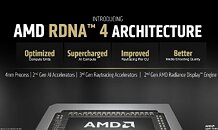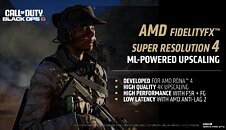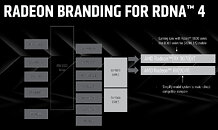- Joined
- Oct 9, 2007
- Messages
- 47,670 (7.43/day)
- Location
- Dublin, Ireland
| System Name | RBMK-1000 |
|---|---|
| Processor | AMD Ryzen 7 5700G |
| Motherboard | Gigabyte B550 AORUS Elite V2 |
| Cooling | DeepCool Gammax L240 V2 |
| Memory | 2x 16GB DDR4-3200 |
| Video Card(s) | Galax RTX 4070 Ti EX |
| Storage | Samsung 990 1TB |
| Display(s) | BenQ 1440p 60 Hz 27-inch |
| Case | Corsair Carbide 100R |
| Audio Device(s) | ASUS SupremeFX S1220A |
| Power Supply | Cooler Master MWE Gold 650W |
| Mouse | ASUS ROG Strix Impact |
| Keyboard | Gamdias Hermes E2 |
| Software | Windows 11 Pro |
Perhaps the biggest surprise at AMD's January 6 CES keynote address was the omission of the Radeon RX 9070 series desktop graphics cards, and the RDNA 4 graphics architecture. This was particularly because the CES Pre-brief slide-deck that AMD provided to press included materials about Radeon, but the actual presentation on stage lacked that content. Immediately after the event, AMD leadership, including David McAfee and Frank Azor agreed to sit down with a small group of tech journalists for a roundtable talk, and we had a seat. In this article, we will try to share what we can. The talk began with addressing the elephant in the room, about why AMD omitted Radeon-related announcements in Jack Huynh's keynote address and the company also confirmed that providing press with pre-brief Radeon info was intentional, and they knew that info wouldn't be included on the main stage.
AMD says that the 45-minute keynote address didn't provide sufficient time to properly announce the Radeon RX 9070 series and RDNA 4. The company pointed to other announcements it omitted in the keynote, such as the Ryzen Z2 line of gaming handheld chips. The company says that Radeon-related announcements, would have needed a much greater time-share in the keynote, to detail the change in the product naming (more on this later), where the RX 9070 series fit into the market, the advancements made by RDNA 4, and new technology such as FSR 4.

AMD said that the Radeon RX 9070 series could see the light of the day in Q1 2025, and that the company will do at least an online media event to launch them. This hour-long presentation will give the team a better opportunity to dive deep into the nuts and bolts of RDNA 4 and the RX 9000 series. The company wouldn't confirm the exact date on which it plans to launch these cards, but we know from the pre-brief presentation that the launch is within Q1 2025, and that all of AMD's add-in board partners have their custom design cards ready.
We then jumped into the rabbit hole of product naming, and why AMD chose to give up a gaming GPU model naming scheme that it had built over three generations of Navi, starting with the RX 5000 series, succeeded by the RX 6000, and the RX 7000. The RX 5000 series now over 5 years old, so the market has had quite a bit of exposure to this naming scheme. AMD first sought to explain why it skipped the RX 8000 series. The company said that it wanted to align the model numbering with the Ryzen 9000 series desktop processors.
In the second half of AMD's answer, the company sought to explain the change from something like the "RX 9700 XT" to the "RX 9070 XT." The rumors are true, AMD wanted to make it easier for gamers to identify competitive positioning of SKUs, by giving them a naming scheme similar to "the competition," namely NVIDIA. This way, gamers would compare the RX 9070 XT to NVIDIA's GeForce RTX 5070 or the RTX 5070 Ti; and the future RX 9060 XT with the RTX 5060 Ti or RTX 5060.
A journalist then asked what was on everyone's mind at that point—if you're doing this to train consumers, then will this naming scheme stick. The Radeon RX "Navi" family is now already at the 9000 series, and the next generation will probably have to either be the "RX 10070" or bring yet another change. To this, AMD agreed that it cannot commit to a naming scheme, it constantly assesses the market and consumer behavior, and implements whatever works.
The next question by one of the journalists sought AMD's comment on what is the decision tree that led to the development of RDNA 4. AMD responded that it wanted to seek volumes, mainly to identify key segments of the market that pushed the most volumes, and then try to win in those segments with products that delivered higher performance per dollar and efficiency. The bulk of the market is running after the 70-series and the 60-series (eg: the RTX 4070 and the RTX 4060), and so AMD could save itself a lot of product development by only focusing on winnable segments. The company does not have to prove its ability to create enthusiast-segment GPUs, that's just not where the market is at. The switch to the 70-series and 60-series naming scheme was more to make it easier to reach out to the market volume.
AMD was also asked for its reaction on the Intel Arc B580 "Battlemage," specifically on how Intel succeeded in winning praise from both the press and gamers for a well-rounded product at $250. AMD's response sounded like they are very impressed with the B580. "I think it's a testament that if you bring features and performance to a great value price-point, it will really resonate with consumers." They seemed to agree that AMD's strategy will be very similar to that of Intel—to impress upon the largest volume segments of the market with high performance/dollar products.
AMD says that it got a lot of praise as well as flack from the RDNA 3 generation, and is trying to replicate the things that brought it praise. The RX 7000 series only had a couple of home-runs, such as the RX 7800 XT and the RX 7900 GRE, and the company's effort will be to replicate the success of those products.

The attention then turned to FSR 4, and a footnote in AMD's pre-brief presentation slide which said that FSR 4 will only be available to the RX 9070 series for supported games with FSR 3.1 already integrated. AMD said that FSR 4 uses a machine-learning based algorithm to reconstruct details in its super resolution component, and that RDNA 4 provides a significant uplift in MLops over the previous generations of RDNA, and so initially FSR 4 will be available on the RX 9000 series, but the company will assess specific SKUs from previous generations that it thinks are capable of the AI acceleration performance needed for FSR 4 SR algorithm to work without imposing a prohibitive performance or latency cost. FSR 4 will be a significant improvement not just in frame-rate at a given preset, but also image quality.
We then asked AMD about its priorities in developing RDNA 4, and explain why they'd ranked something high or something else a bit low. Their priority number 1 was to focus on improving performance in areas that gamers care about the most. You should expect in this generation to see big ray tracing improvements, big MLops (AI acceleration) improvements, for things like FSR 4 and ML Super Resolution.
The second priority is that every component on the GPU is designed for efficiency, not just in terms of energy efficiency, but in terms of the things that will allow AMD to price the product competitively—the right manufacturing process, the right die-size, the right memory type. In other words, AMD is preparing for a very stiff price war against NVIDIA and potentially Intel, where it doesn't want exotic hardware design decisions to erect barriers for the marketing team.
The third and smaller priority was go-to-market. If you recall, AMD was significantly slower than NVIDIA at going to market with the Radeon RX 7000 series. The RX 7900 series arrived at a time when NVIDIA had almost concluded rolling out the RTX 40-series. AMD wants to avoid that this time around, and you should see a fairly brisk set of product launches by AMD in the RX 9000 series.

Lastly, AMD refuted performance claims about the RX 9000 series GPUs doing rounds on the Internet. "Nobody has the final driver, not even the board manufacturers, so don't believe performance claims on the Internet," AMD quipped.
View at TechPowerUp Main Site
AMD says that the 45-minute keynote address didn't provide sufficient time to properly announce the Radeon RX 9070 series and RDNA 4. The company pointed to other announcements it omitted in the keynote, such as the Ryzen Z2 line of gaming handheld chips. The company says that Radeon-related announcements, would have needed a much greater time-share in the keynote, to detail the change in the product naming (more on this later), where the RX 9070 series fit into the market, the advancements made by RDNA 4, and new technology such as FSR 4.

AMD said that the Radeon RX 9070 series could see the light of the day in Q1 2025, and that the company will do at least an online media event to launch them. This hour-long presentation will give the team a better opportunity to dive deep into the nuts and bolts of RDNA 4 and the RX 9000 series. The company wouldn't confirm the exact date on which it plans to launch these cards, but we know from the pre-brief presentation that the launch is within Q1 2025, and that all of AMD's add-in board partners have their custom design cards ready.
We then jumped into the rabbit hole of product naming, and why AMD chose to give up a gaming GPU model naming scheme that it had built over three generations of Navi, starting with the RX 5000 series, succeeded by the RX 6000, and the RX 7000. The RX 5000 series now over 5 years old, so the market has had quite a bit of exposure to this naming scheme. AMD first sought to explain why it skipped the RX 8000 series. The company said that it wanted to align the model numbering with the Ryzen 9000 series desktop processors.
In the second half of AMD's answer, the company sought to explain the change from something like the "RX 9700 XT" to the "RX 9070 XT." The rumors are true, AMD wanted to make it easier for gamers to identify competitive positioning of SKUs, by giving them a naming scheme similar to "the competition," namely NVIDIA. This way, gamers would compare the RX 9070 XT to NVIDIA's GeForce RTX 5070 or the RTX 5070 Ti; and the future RX 9060 XT with the RTX 5060 Ti or RTX 5060.
A journalist then asked what was on everyone's mind at that point—if you're doing this to train consumers, then will this naming scheme stick. The Radeon RX "Navi" family is now already at the 9000 series, and the next generation will probably have to either be the "RX 10070" or bring yet another change. To this, AMD agreed that it cannot commit to a naming scheme, it constantly assesses the market and consumer behavior, and implements whatever works.
The next question by one of the journalists sought AMD's comment on what is the decision tree that led to the development of RDNA 4. AMD responded that it wanted to seek volumes, mainly to identify key segments of the market that pushed the most volumes, and then try to win in those segments with products that delivered higher performance per dollar and efficiency. The bulk of the market is running after the 70-series and the 60-series (eg: the RTX 4070 and the RTX 4060), and so AMD could save itself a lot of product development by only focusing on winnable segments. The company does not have to prove its ability to create enthusiast-segment GPUs, that's just not where the market is at. The switch to the 70-series and 60-series naming scheme was more to make it easier to reach out to the market volume.
AMD was also asked for its reaction on the Intel Arc B580 "Battlemage," specifically on how Intel succeeded in winning praise from both the press and gamers for a well-rounded product at $250. AMD's response sounded like they are very impressed with the B580. "I think it's a testament that if you bring features and performance to a great value price-point, it will really resonate with consumers." They seemed to agree that AMD's strategy will be very similar to that of Intel—to impress upon the largest volume segments of the market with high performance/dollar products.
AMD says that it got a lot of praise as well as flack from the RDNA 3 generation, and is trying to replicate the things that brought it praise. The RX 7000 series only had a couple of home-runs, such as the RX 7800 XT and the RX 7900 GRE, and the company's effort will be to replicate the success of those products.

The attention then turned to FSR 4, and a footnote in AMD's pre-brief presentation slide which said that FSR 4 will only be available to the RX 9070 series for supported games with FSR 3.1 already integrated. AMD said that FSR 4 uses a machine-learning based algorithm to reconstruct details in its super resolution component, and that RDNA 4 provides a significant uplift in MLops over the previous generations of RDNA, and so initially FSR 4 will be available on the RX 9000 series, but the company will assess specific SKUs from previous generations that it thinks are capable of the AI acceleration performance needed for FSR 4 SR algorithm to work without imposing a prohibitive performance or latency cost. FSR 4 will be a significant improvement not just in frame-rate at a given preset, but also image quality.
We then asked AMD about its priorities in developing RDNA 4, and explain why they'd ranked something high or something else a bit low. Their priority number 1 was to focus on improving performance in areas that gamers care about the most. You should expect in this generation to see big ray tracing improvements, big MLops (AI acceleration) improvements, for things like FSR 4 and ML Super Resolution.
The second priority is that every component on the GPU is designed for efficiency, not just in terms of energy efficiency, but in terms of the things that will allow AMD to price the product competitively—the right manufacturing process, the right die-size, the right memory type. In other words, AMD is preparing for a very stiff price war against NVIDIA and potentially Intel, where it doesn't want exotic hardware design decisions to erect barriers for the marketing team.
The third and smaller priority was go-to-market. If you recall, AMD was significantly slower than NVIDIA at going to market with the Radeon RX 7000 series. The RX 7900 series arrived at a time when NVIDIA had almost concluded rolling out the RTX 40-series. AMD wants to avoid that this time around, and you should see a fairly brisk set of product launches by AMD in the RX 9000 series.

Lastly, AMD refuted performance claims about the RX 9000 series GPUs doing rounds on the Internet. "Nobody has the final driver, not even the board manufacturers, so don't believe performance claims on the Internet," AMD quipped.
View at TechPowerUp Main Site









